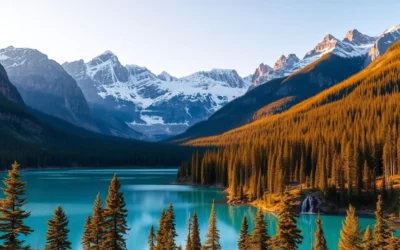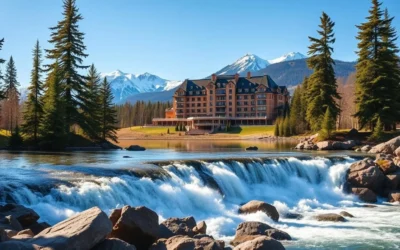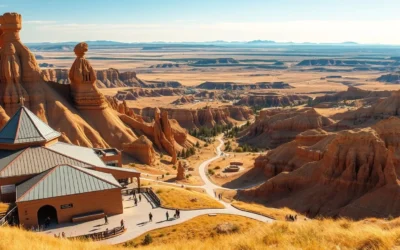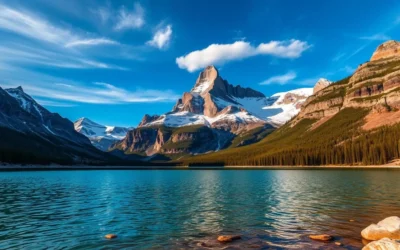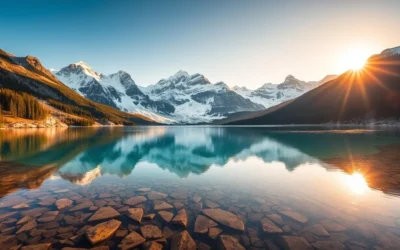✓ Accommodations ✓ Flights ✓ Rental Cars
Imagine driving along a 50-kilometer scenic route that offers some of the most breathtaking views in the Canadian Rockies. The Bow Valley Parkway is a must-drive road that connects Banff to Lake Louise, providing a leisurely journey with numerous opportunities to stop and explore natural attractions.
As you travel along this historic road, you’ll have ample time to take in the stunning views and enjoy the scenic beauty of Banff National Park. With its picturesque landscapes and abundant wildlife, the valley parkway is an ideal destination for nature lovers and outdoor enthusiasts.
Whether you’re planning a day trip or a longer adventure, this guide will help you discover the things to do and see along the Bow Valley Parkway, making your journey unforgettable.
Discovering the Scenic Bow Valley Parkway
The Bow Valley Parkway is a scenic gem in Banff National Park, offering an unforgettable driving experience. As you travel along this route, you’ll be surrounded by the stunning beauty of the Canadian Rockies, with the Bow River running parallel to the Trans-Canada Highway.

What Makes the Bow Valley Parkway Special
The Bow Valley Parkway stands out due to its unique characteristics. Here are a few aspects that make it special:
- Its winding path through montane forests offers intimate views of the surrounding landscape.
- The parkway serves as both a transportation route and a wildlife corridor, making it an ideal spot for wildlife viewing.
- The lower elevation and diverse vegetation create an ecosystem that supports a wide range of wildlife.
The valley parkway is particularly renowned for its wildlife viewing opportunities. With patience and a keen eye, you can spot elk, deer, bears, and other wildlife in their natural habitat.
A Brief History of the Parkway
The Bow Valley Parkway has a rich history dating back to the 1920s when it was first constructed as the main route between Banff and Lake Louise. Before the Trans-Canada Highway was built, this road was the primary connection between these two popular destinations.
Throughout its history, the parkway has evolved from a simple transportation route to a destination in itself, with numerous pullouts, viewpoints, and trailheads added over the decades. Today, it represents a perfect balance between accessibility and wilderness, allowing visitors to experience the raw beauty of the Bow Valley while remaining close to modern amenities.
As you drive along the valley parkway, you’ll appreciate the careful design that prioritized scenic views and access to natural attractions, reflecting the early vision of automobile tourism in Banff National Park.
Planning Your Visit to the Bow Valley Parkway
A visit to the Bow Valley Parkway can be a wonderful experience if you plan your trip according to the season and your interests. The parkway is a 50 km long scenic route that offers breathtaking views and various attractions.
Best Time to Visit
The Bow Valley Parkway is technically open year-round, but the experience varies significantly with the seasons. Summer brings warm weather and abundant wildlife, making it peak tourist season. In contrast, fall offers spectacular autumn colors and fewer crowds, ideal for photography and peaceful exploration.
- Summer (June-August): Warm weather, abundant wildlife, and all attractions accessible.
- Fall (September-October): Spectacular autumn colors, cooler temperatures, and fewer crowds.
- Spring (April-May): Emerging wildlife, flowing waterfalls, and the first wildflowers.
- Winter (November-March): Snow-covered landscapes, frozen waterfalls, but requires winter driving experience.

How Much Time You Need
For a complete experience with stops at major attractions like Johnston Canyon, allow at least half a day to explore the valley parkway. If you plan to include longer hikes or multiple stops, consider allocating a full day to truly appreciate all that the Bow Valley has to offer.
A popular strategy is to drive the Bow Valley Parkway one way and return via the Trans-Canada Highway to save time while still enjoying the scenic route.
How to Access the Bow Valley Parkway
Accessing the Bow Valley Parkway is straightforward, with multiple entry points from Banff, Lake Louise, and Castle Junction. The parkway is a scenic route that runs through Banff National Park, offering stunning views and various attractions along the way.
From Banff
To access the Bow Valley Parkway from Banff, take the Trans-Canada Highway west for approximately 6 kilometers past the Mount Norquay Road exit. Then, look for the clearly marked exit for Highway 1A (Bow Valley Parkway) on your right. You’ll pass by Vermilion Lakes on your left before reaching the exit.
From Lake Louise
When coming from Lake Louise, head towards the Lake Louise Ski Resort on Whitehorn Drive. Watch for the turnoff on your right before reaching Skoki Lodge. This will lead you to the western end of the Bow Valley Parkway.
From Castle Junction
Castle Junction offers a convenient mid-point access to the Bow Valley Parkway. Simply exit the Trans-Canada Highway at Castle Junction, cross the bridge over the Bow River, and choose your direction on the parkway.
It’s worth noting that while GPS navigation can be helpful, some systems may not recognize “Bow Valley Parkway” but will recognize “Highway 1A” as the route designation. Always check current conditions before planning your route, as certain access points may be restricted during seasonal closures or cycling pilot project periods.
| Access Point | Directions |
|---|---|
| Banff | Take Trans-Canada Highway west, exit at Highway 1A |
| Lake Louise | Head to Lake Louise Ski Resort on Whitehorn Drive, turn right before Skoki Lodge |
| Castle Junction | Exit Trans-Canada Highway, cross bridge over Bow River |

Important Travel Restrictions to Know
To ensure a smooth and enjoyable trip, familiarize yourself with the important travel restrictions on the Bow Valley Parkway. The parkway has specific rules in place to protect wildlife and enhance your overall experience.
Seasonal Closures
From March 1 to June 25, 2025, the eastern 17-kilometer section of the Bow Valley Parkway, from the Trans-Canada Highway interchange to Johnston Canyon Campground, is closed to all travel between 8 p.m. and 8 a.m. This nighttime closure is crucial for protecting critical wildlife habitat during the spring when animals are most active.
The closure applies to all forms of travel, including vehicles, bicycles, and pedestrians. This measure ensures that wildlife, particularly large carnivores like bears emerging from hibernation, have a safe habitat.
Cycling Pilot Project
Parks Canada has implemented a cycling pilot project that restricts vehicle access on the eastern section of the Bow Valley Parkway from May 1 to June 25, 2025, and from August 28 to October 2, 2025, between 8 a.m. and 8 p.m. This allows for vehicle-free cycling during these periods.
During the cycling pilot periods, you can still access Johnston Canyon by vehicle via Castle Junction or by cycling from Banff. It’s recommended to bring a bike lock for the canyon hike.

| Type of Restriction | Dates | Times |
|---|---|---|
| Nighttime Closure | March 1 – June 25, 2025 | 8 p.m. – 8 a.m. |
| Cycling Pilot Project | May 1 – June 25, 2025; August 28 – October 2, 2025 | 8 a.m. – 8 p.m. |
Always check the Parks Canada website or visitor centers for the most up-to-date information on closures before setting out on your journey, as restrictions may change based on wildlife activity or weather conditions.
Johnston Canyon: The Crown Jewel

The Bow Valley Parkway’s crown jewel, Johnston Canyon, is a treat for nature lovers. This stunning canyon is a highlight for many on their trip to Banff, offering a family-friendly hiking experience on well-maintained trails that are enjoyable in both winter and summer.
Lower Falls Trail
The Lower Falls trail is a 1.1 km (one-way) hike on a well-maintained path that includes catwalks attached to the canyon walls, offering unique perspectives of the rushing water below. A special feature of the Lower Falls is a small cave tunnel that leads to an up-close viewing platform where you can feel the spray from the powerful waterfall—be prepared to get a little wet!
Upper Falls Trail
The Upper Falls trail continues another 1.6 km beyond the Lower Falls, rewarding hikers with views of a 30-meter waterfall that thunders down the canyon walls in summer and transforms into a massive ice column in winter. Winter visitors to Johnston Canyon are treated to a magical frozen wonderland, with ice climbers often scaling the frozen falls and the metal catwalks dusted with snow.
The Ink Pots Extension
For more adventurous hikers, the trail continues beyond the Upper Falls to the Ink Pots, a series of seven mineral springs that bubble up from below the earth’s surface, creating pools of strikingly colored water. The Ink Pots extension adds another 3 km (one-way) to your hike and climbs out of the canyon into an open meadow with panoramic mountain views that make the extra effort worthwhile.
Due to Johnston Canyon’s immense popularity, it’s advisable to arrive early in the morning or later in the afternoon to avoid the largest crowds, especially during peak summer months when the parking lots fill quickly. With its gift shop, restaurant, cafe, and the Johnston Canyon Bungalows to stay at, Johnston Canyon is a comprehensive destination that caters to various needs.
Castle Mountain Lookout Hike

Hike to the Castle Mountain Lookout for a breathtaking perspective on the Bow Valley Parkway. This 7.4-kilometer trail is a moderately difficult hike that offers one of the most rewarding panoramic views along the parkway.
Trail Details and Difficulty
The Castle Mountain Lookout trailhead is located approximately 30 km from Banff, with a small parking area that’s easy to miss if you’re not watching carefully for the Castle Lookout sign. The trail climbs steadily through pine forest for approximately 3.7 km (one-way) with an elevation gain of about 550 meters, requiring a reasonable level of fitness but no technical hiking skills. Most hikers complete the round trip in 3-4 hours.
What You’ll See at the Top
Upon reaching the summit, you’ll be rewarded with breathtaking 360-degree views of the Bow Valley, with Castle Mountain’s distinctive cliffs dominating the landscape to the west. The lookout offers unobstructed views of surrounding peaks, including Pilot Mountain, Mount Temple, and the Sawback Range, making it an excellent spot for photography. Historically, the lookout was used as a fire watch station, and remnants of the old cabin foundation can still be seen at the top.
Morant’s Curve: Perfect Photo Opportunity

If you’re looking for a perfect photo opportunity, Morant’s Curve on the Bow Valley Parkway is a must-stop destination. This iconic spot is named after Nicholas Morant, a legendary CPR photographer who captured this location for company promotional materials in the mid-20th century.
Best Time for Photography
The best time for photography at Morant’s Curve is during early morning or late afternoon when the light is softer and more directional, creating depth and dimension in your images. Winter photography at Morant’s Curve is particularly magical, with snow-covered mountains and trees creating a pristine backdrop for the colorful Canadian Pacific Railway trains.
Tips for Capturing the Perfect Shot
For the ultimate shot, you’ll need patience to wait for a train to pass through the curve—trains typically run every 30-60 minutes, but schedules vary and are not published for tourists. Local photographers recommend listening for the distant sound of a train whistle, which can give you a few minutes’ warning before the train appears in the frame. When composing your shot, use the natural S-curve of the tracks to lead the viewer’s eye through the frame, and consider including the Bow River and surrounding mountains to create depth.
Morant’s Curve offers a quintessentially Canadian scene with the tracks, the turquoise Bow River, and mountain peaks creating a perfect composition. The small parking area can fill quickly during peak times, so arrive early or be prepared to wait for a spot, and always exercise caution when crossing the road to reach the viewpoint.
Wildlife Viewing Along the Bow Valley Parkway
As you drive along the Bow Valley Parkway, you’ll have the opportunity to see a variety of wildlife native to the Canadian Rockies. The parkway is known for its excellent wildlife viewing opportunities, thanks to its lower elevation and diverse vegetation.
Common Wildlife Sightings
The Bow Valley Parkway is home to a wide range of wildlife, including elk, deer, bighorn sheep, and black bears. Visitors may also spot grizzly bears, wolves, moose, and coyotes, although these sightings are less common. The best times for wildlife viewing are during dawn and dusk when many animals are most active.
The eastern section of the parkway, between Banff and Johnston Canyon, is particularly good for wildlife viewing. This area is protected by seasonal night closures to safeguard the habitat.
| Wildlife | Best Viewing Time | Safe Distance |
|---|---|---|
| Elk, Deer, Bighorn Sheep | Dawn, Dusk | 30 meters (100 feet) |
| Bears, Wolves, Coyotes | Throughout daylight | 100 meters (330 feet) |

Wildlife Safety Tips
When viewing wildlife, it’s essential to maintain a safe distance to protect both you and the animals. Keep your camera ready with a telephoto lens, and never approach wildlife or position yourself between a mother and her young.
If you encounter wildlife while driving, slow down, use your hazard lights, and pull completely off the road if you wish to stop. Never exit your vehicle to approach animals, and avoid feeding wildlife or leaving food accessible in your vehicle or at picnic areas.
By following these guidelines, you can enjoy the wildlife viewing opportunities along the Bow Valley Parkway while ensuring a safe and enjoyable experience for both you and the animals.
Bow Valley Parkway, Alberta: Best Things to Do – Top Picks for Hikers
With its diverse landscapes, the Bow Valley Parkway offers some of the best hiking trails in Banff National Park. As you explore this scenic route, you’ll discover a range of hiking opportunities that cater to different skill levels and interests.
Rockbound Lake Trail
The Rockbound Lake Trail is one of the most popular and challenging hikes along the Bow Valley Parkway. This 9 km one-way trail takes you up the southern slopes of Castle Mountain, ultimately leading you to Rockbound Lake, nestled behind the mountain’s iconic peak. Along the way, you’ll pass Tower Lake, a charming spot that makes for a great turnaround point for those seeking a more moderate hike. The trail gains over 1,000 meters in elevation and typically takes around 7 hours to complete. It’s also renowned for its spectacular golden larch trees in late September, making it one of the best larch hikes in Alberta.

Silverton Falls
For a more accessible and family-friendly hike, Silverton Falls offers a short 1.8 km round-trip walk through a pleasant forest to a cascading 50-meter waterfall. The trailhead is conveniently located near Castle Junction, sharing the same parking area as the Rockbound Lake Trail. This easy hike is perfect for those with limited time or looking for a relaxing stroll amidst nature.
Moose Meadows Trail
The Moose Meadows Trail provides a quieter alternative to the more popular trails like Johnston Canyon. This trail leads you through lush forests and meadows, eventually connecting with the Upper Falls of Johnston Canyon. It’s an ideal choice for those seeking a more serene hiking experience without straying too far from the main attractions of the Bow Valley Parkway.
| Trail Name | Distance | Difficulty | Time to Complete |
|---|---|---|---|
| Rockbound Lake Trail | 18 km round-trip | Challenging | 6-8 hours |
| Silverton Falls | 1.8 km round-trip | Easy | 1-2 hours |
| Moose Meadows Trail | Varies | Moderate | Varies |
The Bow Valley Parkway is a haven for hikers, offering trails that range from easy, family-friendly walks to more challenging mountain ascents. Whether you’re looking for a leisurely stroll or an adventurous hike, the trails along this scenic parkway have something to offer everyone.
Best Viewpoints and Photo Stops
As you drive along the Bow Valley Parkway, you’ll encounter numerous breathtaking viewpoints and photo stops that showcase the Canadian Rockies’ dramatic beauty. The parkway is designed to highlight the natural splendor of the area, with several stops along the way offering unique perspectives on the landscape.
Castle Cliffs Viewpoint
One of the most impressive stops is the Castle Cliffs Viewpoint, which provides a stunning view of Castle Mountain’s eastern face. A short, paved trail leads to a wooden platform that perfectly frames the mountain’s distinctive limestone cliffs. This viewpoint is particularly stunning during golden hour when the setting sun bathes the cliffs in warm light, creating dramatic shadows that highlight the mountain’s unique geological features.
Storm Mountain Lookout
Another fantastic lookout is Storm Mountain Lookout, which offers views across the valley to Storm Mountain and the continental divide. You’ll also have the opportunity to watch trains traverse the valley below. The lookout includes interpretive panels explaining how the continental divide works, adding an educational element to the visit.
Backswamp and Hillsdale Meadows
For a more serene experience, stop at Backswamp, a small, unmarked viewpoint just a few kilometers into the parkway. Here, you’ll enjoy outstanding views of Mount Bourgeau with the Bow River in the foreground. Hillsdale Meadows is another must-visit, offering 360-degree mountain views and seasonal wildflower displays that are particularly impressive in July and early August.
These viewpoints and photo stops along the Bow Valley Parkway are not only visually stunning but also offer a chance to experience the natural beauty of the Canadian Rockies in a more peaceful setting, away from the crowds.
Picnic Areas Along the Parkway
One of the joys of traveling the Bow Valley Parkway is stopping at its picturesque picnic areas. The parkway features several well-maintained picnic areas that provide perfect spots to relax, enjoy a meal, and soak in the mountain scenery away from the crowds.

Muleshoe Picnic Area
The Muleshoe Picnic Area is a large, beautiful spot along the Bow Valley Parkway. Located in a rare section of montane forest in Banff National Park, this area is rich in wildlife. The forest surrounding the 12 picnic tables consists of old-growth aspens and towering evergreen trees. You can enjoy the sound of the trembling aspen leaves, making it a very relaxing spot.
Baker Creek Picnic Area
Another hidden gem is the Baker Creek Picnic Area, located just across the highway from the Baker Creek Mountain Resort. This picturesque picnic area sits next to the beautiful Baker Creek, making it an excellent spot to see wildlife. The creek and the adjacent meadow are prime habitats for some of Banff’s most beautiful creatures. The picnic area has about 8 picnic tables and a short, paved walking trail along the creek.
Coral Creek Picnic Area
The Coral Creek Picnic Area is a real hidden gem along the Bow Valley Parkway. This small creekside clearing is a perfect spot for a picnic near Lake Louise. You can enjoy the sound of rushing water while taking in the views of Mount Temple through the trees. The area features a beautiful stone fireplace next to the river and many picnic tables have charcoal BBQs, making it ideal for cooking a meal outdoors.
All picnic areas along the Bow Valley Parkway include basic facilities such as toilets, garbage and recycling bins, and parking areas. Be sure to bring your own water, as none of the picnic areas offer potable water.
Cycling the Bow Valley Parkway

As a continuation of the Banff Legacy Trail, the Bow Valley Parkway provides a unique opportunity for cyclists to ride from Canmore to Lake Louise. This scenic route is a must-ride for any cycling enthusiast, offering breathtaking mountain vistas and serene lakes.
The Bow Valley Parkway is a 50-kilometer route that involves approximately 550 meters of elevation gain, with most of the climbing occurring on the western half of the route toward Lake Louise. Cyclists can enjoy a continuous paved route that connects with the Banff Legacy Trail, allowing for a truly epic Rocky Mountain cycling experience.
Bike Rental Options
Several bike rental options are available in Banff, including Banff Cycle, which offers both traditional road bikes and e-bikes. E-bikes are particularly helpful for tackling the parkway’s hills and longer distances, making this scenic route accessible to riders of various fitness levels.
Banff Cycle is a reputable rental service that provides high-quality bikes and equipment. You can visit their website or store in Banff to rent a bike that suits your needs.
Tips for a Successful Ride
To ensure a successful and enjoyable ride, be prepared for wildlife encounters by making noise while riding, staying alert, and carrying bear spray. Bears and other wildlife are frequently spotted along the parkway, so it’s essential to be vigilant.
Additionally, consider riding from Banff to Johnston Canyon (approximately 25 km one-way) and then returning, which makes for a manageable day trip with time to explore the canyon. This option allows you to experience the best of the Bow Valley Parkway without feeling overwhelmed.
Where to Stay Along the Bow Valley Parkway
Staying overnight along the Bow Valley Parkway is a great way to experience the tranquility of Banff National Park away from the busier towns of Banff and Lake Louise. You have several charming options to choose from, ranging from cozy cabins to budget-friendly campgrounds.
Baker Creek Mountain Resort
Baker Creek Mountain Resort stands out as a premier accommodation option, featuring 35 charming log cabins and lodge suites nestled alongside Baker Creek, just 10 minutes from Lake Louise. The resort offers a highly-rated restaurant serving locally-inspired cuisine, cozy fireplaces in most units, and immediate access to hiking trails and cross-country ski routes in winter.
Castle Mountain Chalets
Castle Mountain Chalets provides another excellent option near the halfway point of the parkway, with rustic yet comfortable cabins featuring kitchenettes that allow you to prepare your own meals. Located at Castle Junction where the Bow Valley Parkway meets the Trans-Canada Highway, these chalets offer convenient access to both the parkway’s attractions and the wider Banff National Park.
Johnston Canyon Bungalows
Johnston Canyon Resort offers the unique experience of staying in heritage bungalows just steps from the famous canyon, allowing you to explore the waterfalls early in the morning or at sunset when most day visitors have departed. This is an ideal choice for those who want to be close to one of the parkway’s most popular attractions.
For budget travelers, options like the HI Castle Mountain Wilderness Hostel and several campgrounds along the route, including Johnston Canyon Campground and Protection Mountain Campground, offer economical choices for accommodations.
Winter Activities on the Bow Valley Parkway
As winter sets in, the Bow Valley Parkway transforms into a serene and snow-covered landscape, offering a unique experience for visitors. The parkway’s beauty in winter is characterized by snow-covered mountains, frozen lakes, and a serene silence that is a stark contrast to the bustling summer months.
Winter Hiking and Snowshoeing
Winter hiking along the Bow Valley Parkway requires proper equipment, including microspikes or crampons for icy conditions, warm layered clothing, and hiking poles for stability on slippery terrain. Popular destinations include the lower section of Johnston Canyon, the Castle Lookout trail for experienced hikers, and the flat areas around Moose Meadows. Snowshoeing is another excellent way to explore the parkway’s winter landscape, with the meadows and forests offering perfect terrain for this accessible activity.
Winter Driving Tips
Winter driving on the Bow Valley Parkway demands extra caution. Although the road is plowed, it is not maintained to the same standard as the Trans-Canada Highway, and icy sections are common even on sunny days. To ensure a safe journey, maintain a slower speed than the posted limit, keep a greater distance between vehicles, and avoid sudden braking or acceleration. Having winter tires is mandatory in Banff National Park from November to April. Always check road conditions before setting out, and consider carrying emergency supplies, including blankets, food, and water.
Dining Options Along the Route
The scenic Bow Valley Parkway has limited dining options, so it’s wise to come prepared with snacks and know where to stop for a meal. As you enjoy the breathtaking views of the Canadian Rockies, you’ll find a few select places to refuel and refresh.
Restaurant Recommendations
For a memorable dining experience, consider visiting Baker Creek Bistro at Baker Creek Mountain Resort, which offers locally-inspired cuisine in a rustic-elegant setting. Another option is the restaurant at Johnston Canyon Resort, providing casual dining with a focus on Canadian ingredients. If you’re staying at Castle Mountain Chalets, you can purchase basic groceries and snacks at their convenience store.
- Baker Creek Bistro serves fine dining with a focus on Canadian ingredients and an excellent wine list.
- The restaurant at Johnston Canyon Resort offers breakfast, lunch, and dinner during the summer season, along with a cafe for quick bites and refreshments.
- Castle Mountain Chalets features a small convenience store for basic supplies, though prices are higher than in town.
Picnic and Self-Catering Tips
For those who prefer to self-cater, the Muleshoe, Baker Creek, and Coral Creek Picnic Areas along the Bow Valley Parkway offer beautiful settings for enjoying your meals. To make the most of your picnic, consider packing a cooler with perishables, bringing a portable stove for hot drinks or simple meals, and stocking up on supplies in either Lake Louise or Banff before heading onto the parkway.
During winter, dining options become even more limited, so advance planning is especially important. If you’re staying overnight along the parkway, accommodations with kitchenettes, like Castle Mountain Chalets, allow for meal preparation, which can be both economical and convenient.
Conclusion: Making the Most of Your Bow Valley Parkway Adventure
With its breathtaking landscapes and abundant wildlife, the Bow Valley Parkway is a journey you won’t soon forget. As you drive along this scenic route, you’ll have the opportunity to experience the natural beauty of Banff National Park and visit some of its most spectacular attractions.
To make the most of your trip to the Bow Valley Parkway, consider driving the parkway one-way from Banff to Lake Louise and returning via the Trans-Canada Highway. This will allow you to experience the scenic route without doubling back. Allocate at least half a day to explore the parkway properly, or a full day if you plan to include hikes like Johnston Canyon or Castle Mountain Lookout in your adventure itinerary.
Visiting during the shoulder seasons (late May-June or September-October) will help you avoid crowds while still enjoying good weather and access to most attractions. Take advantage of the cycling pilot project periods if you enjoy biking, as the vehicle-free eastern section provides a rare opportunity to experience the valley parkway without traffic.
By planning your visit carefully and making the most of your time on the Bow Valley Parkway, you’ll be able to immerse yourself in the natural beauty of this special place in the Canadian Rockies. So take your time, make frequent stops, and enjoy the journey!
—
The above is subject to change.
Check back often to TRAVEL.COM for the latest travel tips and deals.

